Page Table of Contents
About the Author
Hot Topics
Updated on Jun 17, 2024
Overview of PC Data Storage Solutions
The importance of storage devices cannot be overemphasized in the world today. Technology has come a long way since the first hard drive was produced. From then until now, hard drives have gone through many changes.
A hard drive is essentially a computer's permanent memory. It retains information even after the power has been switched off. A typical hard drive will store gigabytes of data, which are bytes of digital inputs from the different programs used by the computer.
All hard drives are not created equal. It is vital to evaluate a storage device and determine whether it will meet your needs and be efficient for the project at hand. There are two main types of hard drives: Solid-state drives (SSD) and Serial Advanced Technology Attachment (SATA). Let's look at them so you can determine which type to use when creating your system.
Although both types of storage devices are commonly used in modern computers and laptops, there are many differences between SATA and SSD Drives. Among the many things they differ in are performance and price. It is not an easy job to evaluate both options. So, I have prepared the following guide for those interested in finding out the main differences between SSDs vs. SATA HDDs.
Read also: TF card vs. SD card
What Is SATA & SATA Drive?
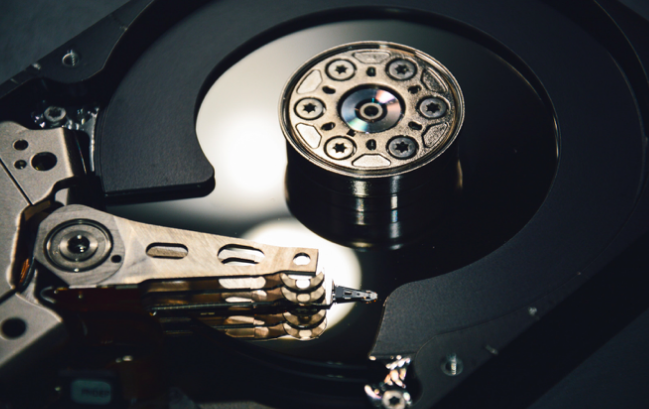
SATA (Serial ATA) is the most popular storage interface today and is used for most consumer-grade hard drives. SATA was developed and introduced by Intel in 2003. Since then, it has become the standard for connecting an HDD to a desktop or laptop computer. It is also used for solid-state drives and optical drives. SATA practically replaced Parallel ATA (PATA) for storage devices. Since 2004, virtually all desktop-grade motherboards have had a SATA bus and port.
SATA drives are an efficient way to bundle large amounts of hard drive space into as small as possible. The downside of using these drives is that there are moving parts in each drive, making them vulnerable to shock and sudden movement. Also, since data is being written across the entire disk, which later on can become fragmented, hindering read/write times. These drives are recommended for standard-sized towers (compared to laptops) since they have more room to dissipate heat.
SATA drives are an example of a rotating media storage device, and as such, they have several drawbacks compared to their flash-based counterparts. Note, however, that in most cases, the inherent plug-and-play advantages, as well as versatility and compatibility with existing hardware, make them an appropriate choice for laptops.
Advantages of SATA Drive
SATA drives are one of the cheapest storage solutions out there. These drives allow you to have more storage on multiple hard drives, which means that you can get your money's worth by purchasing a colossal drive instead of several drives of smaller capacities.
SATA drives are typically used for mass storage of files such as movies, photos, and software applications.
These drives are also great for network servers or other high-capacity applications where there are large amounts of data transfer occurring.
SATA drives also offer less expensive storage space and add flexibility to allow for numerous devices of different storage amounts to be plugged into a computer or server. It is therefore beneficial to use on a file server that will have dozens or even hundreds of users accessing different amounts of data at various times.
Disadvantages
It has been widely accepted that SATA Drives are not good for laptops because of their high energy consumption and increased risk of failure.
The biggest disadvantage of SATA drives is their vulnerability to shock as the platters inside the drive spin at high speeds. When a SATA drive experiences an abrupt shock, such as dropping your laptop, the heads on the platters get knocked out of position, sending bad sectors throughout the drive. Over time, more and more bad sectors will develop, making data recovery costs rise dramatically.
HDD is the right choice for these reasons:
- If you are like most computer consumers, who need massive storage capacity and don't want to spend too much money on a new SSD, it makes sense to buy a hard disk drive (HDD).
- An HDD has more storage capacity and is much cheaper than an SSD.
- For the average consumer's purposes, if speed is not at a premium or user convenience becomes a major factor, then an HDD becomes a better choice.
- If all you do is surf the internet, use basic apps, then an HDD is more than enough.
Therefore, if you are looking for a storage device that can be used in a system with an average need, including using it as a storage device, or wish to add additional storage to your laptop, you should stick to HDD.
What Is an SSD?
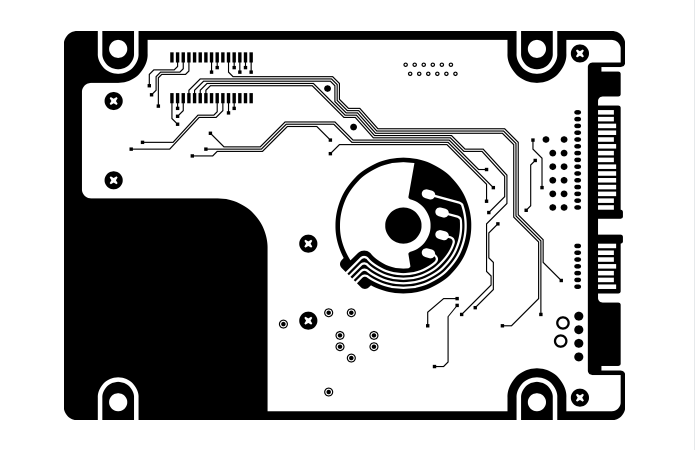
SSD is a computer storage device that uses flash memory to store data persistently. SSDs are faster than other types of storage, including standard hard drives, due to their internal architecture and design. They communicate with a computer bus at speeds like RAM and have no moving parts, making them less prone to failure than standard hard disk drives. SSDs are also silent when in use — essential for laptop computers or desktop computers on your desk.
In the computer world, solid state drives (SSD) are all the rage. They are, without a doubt, faster than traditional drives. But why? Traditional hard drives usually use a motor connected to a small metal arm. The motor spins and moves the arm, which then reads or writes data directly off the platter in the hard disk. It is possible to read multiple disks simultaneously, but that simply pushes up against performance limits.
Advantages
- SSDs are significantly faster than traditional hard disks. They are rugged, silent, and do not overheat.
Note: for more information about SSD temperature, click: can SSD overheat?
- SSDs (solid-state drives) provide much better performance compared to HDDs, particularly for random read and write operations. Files stored on a solid-state drive can be accessed quickly since they have no moving parts and don’t have to be physically read from anywhere in particular.
- Solid-state drives dramatically speed up the computer and reduce lag and latency.
- Its fast access times and high data transfer enable you to work faster.
- SSD has an incredible processing speed, so opening applications and turning on a laptop is lightning fast!
Disadvantages
- They are more expensive and not as large as traditional hard drives.
- Unlike hard disk drives (HDDs), they have a limited number of writes. This means the more you access files on an SSD drive, the faster it will wear out. Over time, the performance of your SSD will degrade, and files may start taking longer to open.
SSD is the right choice for these reasons:
- An SSD is an effective solution for many uses that require significant reading and writing because it is faster than any other storage option.
- SSDs are the right choice for people who need to speed up their computers to play highly intensive games.
- Due to their faster access times and low noise, SSDs are perfect for video editing and music production.
- If you are a power user with intensive needs, like opening apps instantaneously, remarkable productivity, and quick boot-up, then fast SSD storage is quintessential.
If you work in graphics design, video production, and so on, or perhaps you just want the fastest computer for non-professionals and prefer a performance upgrade for your own enjoyment. I recommend you opt for SSD storage instead of an HDD storage device.
SATA Drive vs SSD: Which One Should You Choose?
The Serial ATA (SATA) standard is used in modern desktop and laptop computers. It is the most common interface for SATA drives, which are available at storage capacities ranging from 500 GB to 16 TB. Although SATA drives usually don't offer the fastest access time or performance for random I/O or small file transfers, they remain popular due to their low cost.
SSD vs. HDD: Speed & Performance
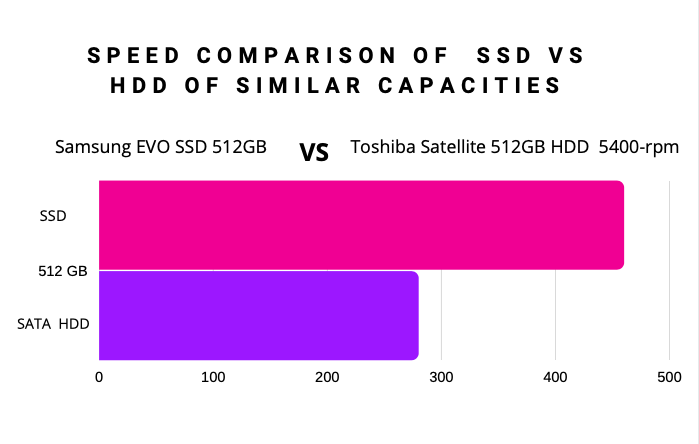
SSD's impact on PC performance is immediately apparent. Startup times are cut in half, as are application and operating-system launch times. Users experience near instantaneous system responsiveness, even when booting into sophisticated and demanding operating systems. SSDs are also excellent for gaming PCs because most graphic-intensive games load in seconds.
SSDs have lower latency than HDDs. This makes them well suited for applications where 3D-streaming of data over high-speed connections (including gigabit Ethernet) or significant random access is required (e.g., infrastructure for data centers).
Whether you're a student finishing homework on the computer or an artist working on a digital painting, an SSD speeds up your activity and unlocks a faster way of doing work. With a solid-state drive (SSD) in your system, you'll enjoy faster boot-up times and optimized performance.
SSD vs. HDD: Price
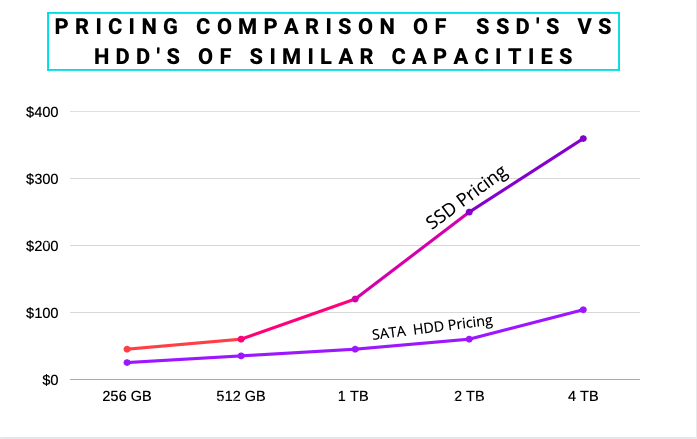
One of the main differences between HDDs and SSDs is price. SATA SSDs are still well behind SATA HDDs in terms of capacity and price per gigabyte. Though the price gap has been shrinking since SSDs first appeared, the two technologies still follow a classic pattern of exponential growth in capacity with steady falling prices. While an SSD will cost you more than a hard drive, the increases are marginal. The speed increase is worth it for most users. Also, note that SSDs will be more economical, as storage sizes continue to grow into the TB range.
The pricing of Solid State Drives (SSDs) and Hard Disk Drives (HDDs) has been converging for years, with the rise of lower-cost, higher-capacity SSDs bringing these prices down. The following charts show the average price per gigabyte for consumer-grade drives, also demonstrate the trend toward even tighter pricing as it becomes more widely used. Both prices per gigabyte and capacity per dollar are on a decline when factoring in advancements in technology and manufacturing efficiency.
If you need a lot of cheap storage and don’t care about speed, or you need physical drives for one thing or another, the SATA HDD is the way to go. While SATA drives are less expensive than SSD drives, they can also be slower and less reliable due to their high power consumption.
SSD vs. HDD: Reliability & Durability
For simple and not extreme-load work, a conventional SATA HDD is sufficient for some applications. For example, you can use it as a backup system, where you store copies of your files or copy large amounts of data to them. However, some tasks that require significant computing power may be slow and cumbersome. For this purpose, you are advised to install an SSD drive.
Flash memory is nonvolatile, allowing the content to be stored even after the power is off. Due to this, there are no moving parts and no chance of mechanical failure. This makes them ideal for use in high-stress environments, like laptops or video game consoles, where there is a risk of physical damage.
How to Replace SATA Drive with SSD
SSD is a formidable contender to replace the spinning hard drive and is appearing in laptops. An SSD provides a significant performance boost in areas where there are only a few seconds (or fractions of a second) between making decisions on whether to save or discard data.
If you're looking for a reliable way to store data, especially something portable and can withstand the rigors associated with travel, solid-state drive is an excellent option. They're quick and durable, making them a perfect solution for business or creative professionals who do all their work on one machine.
Upgrading hard disk drive to solid state drive (SSD) is the ultimate solution for better computer performance. You switch from HDD to SSD due to its speed and convenience, but there is something you should pay attention to. If you have an OS installed on the HDD, you have to clone it to a new desktop SSD using a reliable partition tool or migrate OS from HDD to SSD.
Migrating a hard drive to Solid State Drive (SSD) is a well accepted practice that can tremendously boost both the performance and reliability of the system. Many tech experts actually recommend doing so. However, migrating an HDD to SSD is not a trivial task. The challenges - possible data loss and ineffective migration due to the use of the old hard disk partition layout - are common issues faced by users before stumbling upon an ideal HDD migration solution.
What's The Best HDD to SSD Migration Tool?
EaseUS Partition Master offers an array of HDD to SSD migration or cloning ways to help you transfer the entire hard drive or a selected disk partition.
EaseUS Partition Master is a powerful hard disk manager and partition magic software that deploys powerful data management functions to help you achieve the hard drive migration most efficiently. Its features include Resizing/Moving partitions, Copy Disk, Create/Delete Partition, Format/Convert MBR and GPT disk, etc.
With the "Migrate OS to SSD" feature of EaseUS Partition Master Professional Edition, you can easily and quickly migrate Windows systems, applications and data to the new Solid State Drive without reinstalling Windows.
With just a few clicks, the clone function can duplicate a disk or partition and move it to another SSD or SATA HDD. The new disk keeps the same capacity, format, system, and other attributes as the original one. EaseUS Partition Master can help you copy a partition or an entire disk with just a few clicks. The application supports HDD to HDD, HDD to SSD, and SSD to SSD disk migration. In addition, you can migrate the OS from HDD to SSD.
When the partition size of the source disk is larger than the destination disk, you must clone the partition that contains Windows to move Windows or other applications to SSD. But if it is smaller, you can clone the whole disk, with Migrate OS to SSD.
How to Migrate OS to SSD with EaseUS Partition Master
Steps to migrate OS to HDD/SSD:
- Run EaseUS Partition Master, and select "Clone" from the left menu.
- Check "Migrate OS" and click "Next".
- Select the SSD or HDD as the destination disk and click "Next".
- Check Warning: the data and partitions on the target disk will be deleted. Make sure that you've backed up important data in advance. If not, do it now.
- Then click "Yes".
- Preview the layout of your target disk. Then click "Start" to start migrating your OS to a new disk.
- After this, click "Reboot Now" or "Done" to determine if you want to reboot the computer from the new disk immediately.
"Reboot Now" means to keep the changes instantly, while "Done" means you need to restart the computer later manually.
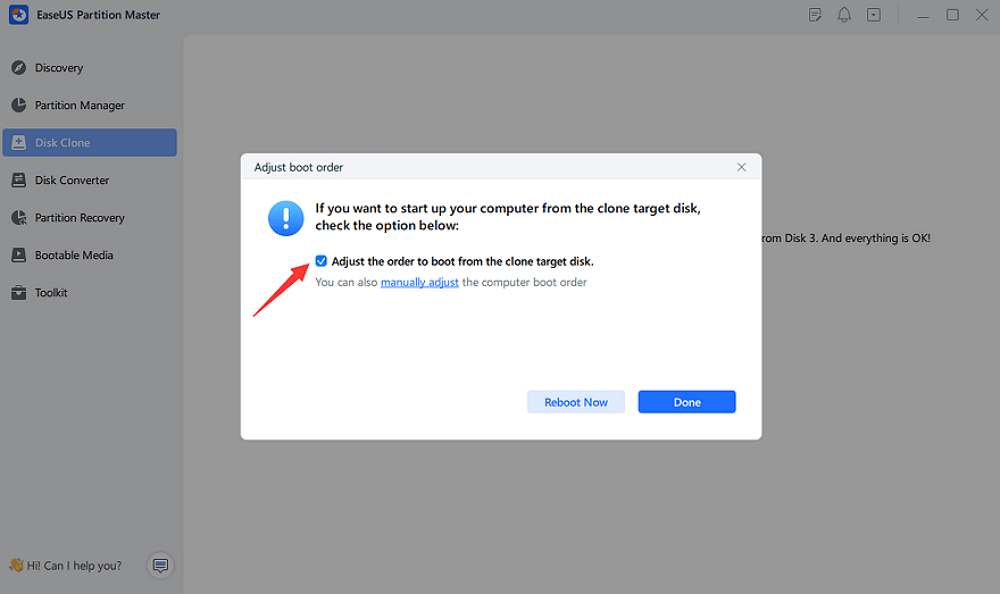
Note: The operation of migrating OS to SSD or HDD will delete and remove existing partitions and data on your target disk when there is not enough unallocated space on the target disk. If you saved important data there, back up them to an external hard drive in advance.
A solid-state drive (SSD) will breathe new life into your computer, taking it from sluggish, tedious, and frustrating to fast, snappy, and magnificent. Now is the time to upgrade your storage.
How Can We Help You
About the Author
Oliver is an EaseUS professional writer who dares explore new areas. With a passion for solving tech issues with straightforward guides for common users, Oliver keeps honing his writing craft by developing in-depth solutions for disk and partition management, computer boot-up issues, file transfer, etc.
Jean is recognized as one of the most professional writers in EaseUS. She has kept improving her writing skills over the past 10 years and helped millions of her readers solve their tech problems on PC, Mac, and iOS devices.
Product Reviews
-
I love that the changes you make with EaseUS Partition Master Free aren't immediately applied to the disks. It makes it way easier to play out what will happen after you've made all the changes. I also think the overall look and feel of EaseUS Partition Master Free makes whatever you're doing with your computer's partitions easy.
Read More -
Partition Master Free can Resize, Move, Merge, Migrate, and Copy disks or partitions; convert to local, change label, defragment, check and explore partition; and much more. A premium upgrade adds free tech support and the ability to resize dynamic volumes.
Read More -
It won't hot image your drives or align them, but since it's coupled with a partition manager, it allows you do perform many tasks at once, instead of just cloning drives. You can move partitions around, resize them, defragment, and more, along with the other tools you'd expect from a cloning tool.
Read More
Related Articles
-
Selected Boot Device Failed - 6 Quick Fixes with Pictures
![author icon]() Sherly/2024/10/11
Sherly/2024/10/11 -
Steam Is Not Recognizing SSD, Here Is What I Can Do
![author icon]() Tracy King/2024/10/23
Tracy King/2024/10/23 -
How to Format SD Card to FAT32 on Mac | 3 Ways
![author icon]() Roxanne/2024/11/05
Roxanne/2024/11/05 -
How to Change Cluster Size Without Formatting 🔥
![author icon]() Sherly/2024/04/22
Sherly/2024/04/22
Hot Topics in 2024
EaseUS Partition Master

Manage partitions and optimize disks efficiently








